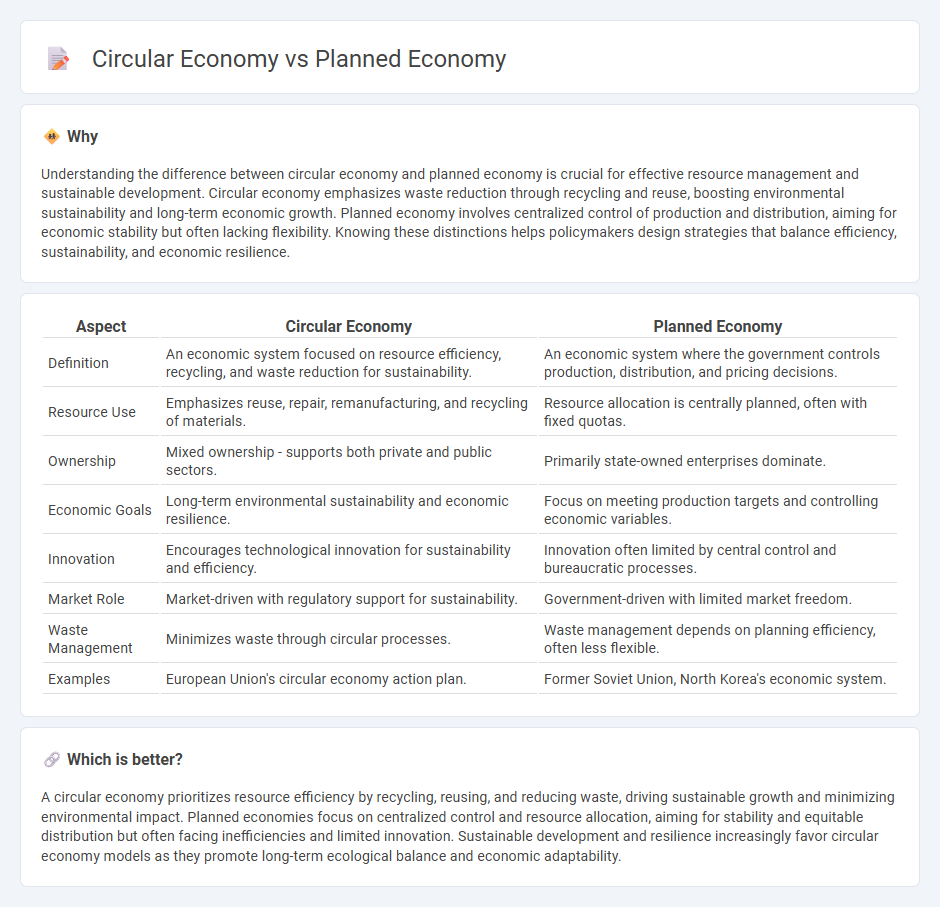
Circular economy emphasizes resource efficiency by minimizing waste and promoting recycling, thereby supporting sustainable development and reducing environmental impact. Planned economy relies on centralized government control and allocation of resources to achieve economic goals and maintain stability. Explore the key differences and implications of these economic models to understand their roles in future growth.
Why it is important
Understanding the difference between circular economy and planned economy is crucial for effective resource management and sustainable development. Circular economy emphasizes waste reduction through recycling and reuse, boosting environmental sustainability and long-term economic growth. Planned economy involves centralized control of production and distribution, aiming for economic stability but often lacking flexibility. Knowing these distinctions helps policymakers design strategies that balance efficiency, sustainability, and economic resilience.
Comparison Table
| Aspect | Circular Economy | Planned Economy |
|---|---|---|
| Definition | An economic system focused on resource efficiency, recycling, and waste reduction for sustainability. | An economic system where the government controls production, distribution, and pricing decisions. |
| Resource Use | Emphasizes reuse, repair, remanufacturing, and recycling of materials. | Resource allocation is centrally planned, often with fixed quotas. |
| Ownership | Mixed ownership - supports both private and public sectors. | Primarily state-owned enterprises dominate. |
| Economic Goals | Long-term environmental sustainability and economic resilience. | Focus on meeting production targets and controlling economic variables. |
| Innovation | Encourages technological innovation for sustainability and efficiency. | Innovation often limited by central control and bureaucratic processes. |
| Market Role | Market-driven with regulatory support for sustainability. | Government-driven with limited market freedom. |
| Waste Management | Minimizes waste through circular processes. | Waste management depends on planning efficiency, often less flexible. |
| Examples | European Union's circular economy action plan. | Former Soviet Union, North Korea's economic system. |
Which is better?
A circular economy prioritizes resource efficiency by recycling, reusing, and reducing waste, driving sustainable growth and minimizing environmental impact. Planned economies focus on centralized control and resource allocation, aiming for stability and equitable distribution but often facing inefficiencies and limited innovation. Sustainable development and resilience increasingly favor circular economy models as they promote long-term ecological balance and economic adaptability.
Connection
Circular economy and planned economy intersect through their shared goal of resource optimization and sustainability, where circular economy focuses on minimizing waste via reuse and recycling, and planned economy emphasizes centralized control over production and allocation to meet societal needs efficiently. In a planned economy, policies can enforce circular economic practices to reduce environmental impact and promote long-term economic resilience. Both systems prioritize reducing resource depletion, optimizing supply chains, and fostering sustainable economic growth through deliberate regulation and strategic planning.
Key Terms
Centralized Planning
Centralized planning in a planned economy directs resource allocation and production decisions through government control, minimizing market-driven influences for efficiency and social equity. The circular economy emphasizes resource reuse and sustainability but can integrate centralized planning to optimize waste management and material flows on a systemic scale. Explore the nuances of how centralized planning shapes economic models and sustainability practices for deeper insights.
Resource Efficiency
A planned economy orchestrates resource allocation through centralized control, often leading to fixed production quotas and potential inefficiencies in resource utilization. In contrast, a circular economy emphasizes maximizing resource efficiency by designing systems that promote reuse, recycling, and minimal waste generation. Explore deeper insights into how these economic models impact sustainability and resource management.
Waste Minimization
A planned economy centrally manages production and resource allocation to minimize waste through strict regulation and efficiency targets. The circular economy emphasizes designing out waste by promoting reuse, recycling, and regenerative practices to create a closed-loop system. Explore how these economic models approach waste minimization and their impact on sustainability strategies.
Source and External Links
Planned economy | EBSCO Research Starters - A planned economy is an economic system where a central authority controls production and distribution of goods and services to meet societal needs, often aiming for fairness and efficiency, though it faces challenges such as bureaucratic inefficiencies and poor forecasting.
Planned Economy: Features, Examples and Benefits - Navi - In a planned economy, financial decisions are centrally controlled by the government to prioritize public welfare and equal resource distribution, with North Korea being a current example of a nation practicing this system.
Planned economy - Wikipedia - Planned economies can be centralized, with a single authority making economic decisions, or decentralized, involving distributed networks and democratic decision-making processes, offering alternatives to market economies.
 dowidth.com
dowidth.com